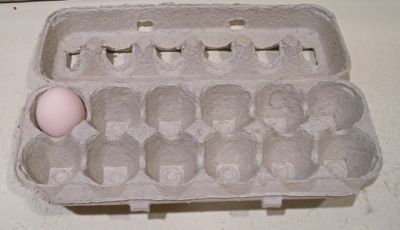This was filmed in April 2009 for Wellesley Cable Access. Candy was particularly (and surprisingly) well behaved.
Monthly Archives: April 2009
Rabbits and Chickens
Having a rabbit living with your hens is as adorable and fun as it appears on HenCam. I frequently get emails asking for advice about how to set up a similar barnyard arrangement. I’m no expert on bunny-chicken co-habitation; Candy is my first rabbit that I’ve put in with the chickens, but I’ll tell you what I’ve done to keep everyone healthy and happy, and perhaps you can do it, too.
Candy had been a house rabbit, but not only do I have allergies, but rabbits shed fine fur everywhere, and the final straw to putting her outside was when my son’s electric trains couldn’t run because of bunny fur in the wheels and motors.
It was springtime, so the weather was fine to put her out. (You can’t put an indoor rabbit out in the winter – they haven’t grown their thick, warm coat.) I keep a close eye on the temperature. Rabbits do just fine in very cold weather. But, since Candy is a lop-ear, she can’t pin her ears to her sides to stay warm, or put them upright to cool off. So, in the winter, the hutch is positioned in the sun and in the summer it is moved to the side of the coop, where it is always shady. Rabbits can suffer heat stroke, so in the worst of the summer weather, I put her in the spare stall in the barn, where she can stretch out on the cool concrete.
I bought a typical rabbit hutch. I’d never keep a bunny outdoor if that’s all the room available – rabbits need to sit up, and run, and stretch out and leap about. They are curious and need mental stimulation – places to explore and new things to see. Candy gets the full run of the HenCam yard and coop during the day. Rabbits burrow, but the fence is dug 6 inches down, so she can’t get out. There’s hawk netting above.
The hutch is Candy’s safe place, not only to give her a haven away from the chickens when she wants it, but also to keep her from predators. She is always locked up at night. In the morning, I open the door and put up the ramp. If I’m late, she rings the bell! (She has parrot chew toys in her hutch.) When the chickens are allowed out to free-range, I close Candy up in her hutch. Unlike the hens, she doesn’t come when called. Besides, it would take just one loose neighborhood dog to lose her. It’s just not worth the risk.
Candy has fresh hay, rabbit pellets and water in her hutch. But, she also drinks from the chicken waterer (which is heated in the winter and she appreciates), she sometimes eats the chicken feed (no problem, it’s vegetarian and she doesn’t eat much) and she gets to try all of the vegetable scraps that I toss to the hens. Of course, Candy gets special handfuls of clover and parsley. She gets lots of exercise and my vet says that she’s the happiest, healthiest bunny he knows. (One caveat- rabbits chew on everything! Keep all wires out of the way or in conduits. They love foam insulation. Put it behind plywood. Don’t leave your plastic buckets where the rabbit can shred it.)
She doesn’t need much special care. I haven’t had to trim Candy’s nails, because she digs in the dirt. I do sometimes put ointment on her ears because they get dry and sunburned.
Candy seems to enjoy the hens’ company. She’ll plop herself in the middle of them. Sometimes she’ll join them in the coop. Once I found her in a nesting box! The chickens tolerate her, although they don’t like it when Candy teases them by galloping through them when they dust bathe!
It was not a big production to introduce Candy to the flock. I kept her in the hutch for a week, where she could watch the hens, and they could see her (if they craned their necks up, which being curious chickens, they did.) Then, I closed the chickens in the coop and let Candy out to explore the fenced yard. I had her practice going up and down the ramp. Then I let out the chickens. They were a tad surprised! But, soon, everyone mingled happily. It helps that there is plenty of space. The indoor coop is 8 x 6 feet and the outdoor run is 15 x 20 feet. There’s shade, sun, roosts and shelter.
I can’t guarantee that you’ll have the same experience I’ve had, but it’s worth a try!
The 80¢ Egg
I know it was cold and windy and dreary yesterday, but was that cause enough for the hens to slack off? I mean, really, just one egg? From thirteen hens? Here it is.

I don’t usually compare the cost of raising homegrown eggs to the supermarket commodity. I know that the ones I get are oh, so much better, and that the benefits of keeping chickens goes beyond the eggs that they produce.
Still. One egg?
On average, each hen consumes 1/4 pound of laying hen feed a day. Which comes to 6¢ per bird. Times by 13, and add a couple of pennies to cover the scratch corn and it comes to an egg that cost 80¢. (Don’t even ask me to factor in the electricity, the feeders, the oyster shell, etc. etc.)
This is why commercial farmers don’t keep older hens. A hen younger than two years usually lays five to six eggs a week (about once every 26 hours from spring through fall). An older hen lays one egg every few days, if that. Buffy is three. Twinkydink and Blackie hatched in May of 2005. Marge and Petunia are now five years old! Currently, we’re getting an average of 5 eggs a day from the thirteen hens. All things considered, not too bad.
The solution here isn’t to get rid of the old girls – instead I think I’ll stop doing the math. And, maybe I need some new, young chickens?
Heritage Chickens
It’s that time of year when feed stores sell oh-so-adorable cheeping chicks. Post offices get deliveries of boxes of peeping yellow fluff. I’m not getting chicks this year, but I have friends who are. An ongoing topic of conversation is which hatchery to order from and what breeds to get.
The buzz words these days are “heritage breed.” Everyone likes the idea of old-fashioned chickens that are bred for traits important to the family farm, not the factory farm. These include a docile temperament, longevity, ability to naturally breed, and eagerness to forage. But, buzz words are often co-opted by people who don’t believe in the program. Look at what’s happened to “natural,” “free-range,” and “organic.”
Thankfully, the people at the American Livestock Breed Conservancy (ALBC) have codified what a heritage breed is. They’ve also created a web site that links you to the breeders.
Even if you don’t have chickens, consider joining the ALBC. They do important work, could really use your support, and send out a newsletter with pictures of the most endearing animals. Have you ever seen a Mammoth Mule?
Bunny Antics
She looks darling and innocent, doesn’t she?

Candy is sweet. But she is a bunny, and that means she is curious and she chews. Even kept outside, a rabbit can do a lot of damage. When she first moved into the hencam barn, she chewed up the wire leading to the camera (which we thought was tucked up high and out of the way.) The wire is now covered with a sturdy conduit. Two summers ago, she got into my asparagus patch and in just an hour, dug a tunnel under the plants and ate up the roots. It takes a couple of years to establish a productive asparagus bed. Mine is well behind schedule.
This week you probably have noticed the cheerful yellow sign in front of the hencam camera. I have a standing offer to schools and libraries that if they are reading Tillie Lays an Egg, that I’ll put a hello! message up there for them. Candy noticed that sign. For some reason, bunnies LOVE to chew on plastic. She tore it to bits. I now have my hello! sign up on the hencam screen, not physically in the coop. Oh well, it works.
